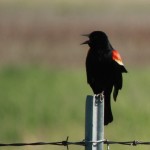Out for a run along the river last week, I noticed something flicker at the edge of my vision and looked up just in time to see a cedar waxwing launching itself upward from a branch to snatch a dragonfly in mid-air.
I stopped running and watched the bird land again on the dead branch, where it appeared to reposition the big insect that was sticking out in all directions from its tiny beak. Then the waxwing flew off with its prey, and I knew that somewhere nearby was a cedar waxwing nest with one or more hungry youngsters.
Whatever else I may be doing, when I’m outside, I’m always looking and listening for birds. To a birdwatcher, that’s almost as automatic as breathing. As a beginner years ago, I was drawn not only to the aesthetic pleasures of birdwatching, but also to the challenge of memorizing and distinguishing the sometimes-subtle traits of hundreds of different species. And I learned to love the thrill of tiptoeing toward a bird without frightening it.
But most of all, I like to watch what birds do. In late April I watched white-throated and white-crowned sparrows rummage through the brush for food they needed to continue their northward migration. In May, I walked the trails and listened to pewees, song sparrows, common yellowthroats, catbirds, and others, all singing about the fine territories they’d claimed. Next was courtship: pairs of robins twirled in flight; wrens chased through the shrubs; and the males and females of other species perched a few feet apart on branches or wires, apparently looking each other over. When I saw a great-crested flycatcher with a bill full of grasses, I knew it had chosen a mate and was building a nest. In June, birds that fidgeted on a perch or even dive-bombed passersby told me there must be a nest in the vicinity. And this month, a songbird that flies away carrying food – instead of eating it –suggests that its nest is full of new life.
Observing the private lives of birds – and understanding what they’re up to – really gives me a sense of having an insider’s knowledge of what’s outside my back door.
Two excellent resources for learning about the lives of birds are The Sibley Guide to Bird Life and Behavior and The Birder’s Handbook by Ehrlich, Dobkin, and Wheye. In the richly illustrated Sibley guide, each chapter covers the natural history of each bird family – waterfowl, woodpeckers, thrushes, and so on – including some details on individual species. The Handbook, on the other hand, has almost no illustrations, but provides detailed accounts of each species, including breeding habitat, courtship, nests, eggs, diet. (Both books are supplements to ID guides, which we’ll look at in a future post).
Online, my favorite resource is the Cornell Lab of Ornithology’s indispensable website, www.allaboutbirds.org.



